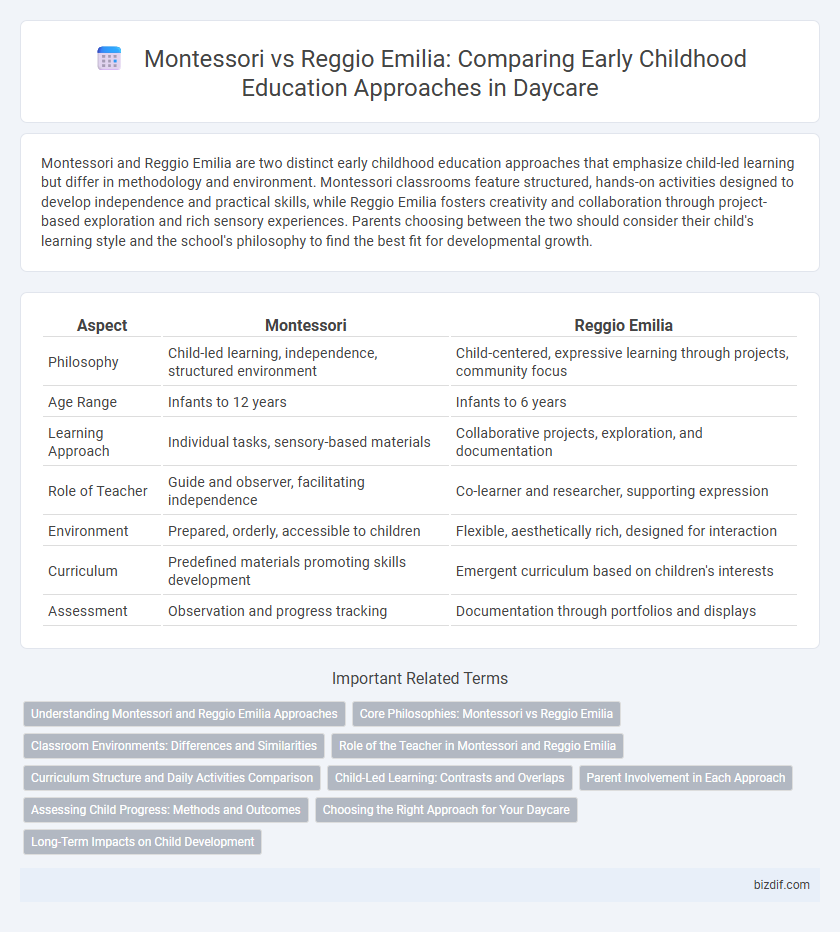Montessori and Reggio Emilia are two distinct early childhood education approaches that emphasize child-led learning but differ in methodology and environment. Montessori classrooms feature structured, hands-on activities designed to develop independence and practical skills, while Reggio Emilia fosters creativity and collaboration through project-based exploration and rich sensory experiences. Parents choosing between the two should consider their child's learning style and the school's philosophy to find the best fit for developmental growth.
Table of Comparison
| Aspect | Montessori | Reggio Emilia |
|---|---|---|
| Philosophy | Child-led learning, independence, structured environment | Child-centered, expressive learning through projects, community focus |
| Age Range | Infants to 12 years | Infants to 6 years |
| Learning Approach | Individual tasks, sensory-based materials | Collaborative projects, exploration, and documentation |
| Role of Teacher | Guide and observer, facilitating independence | Co-learner and researcher, supporting expression |
| Environment | Prepared, orderly, accessible to children | Flexible, aesthetically rich, designed for interaction |
| Curriculum | Predefined materials promoting skills development | Emergent curriculum based on children's interests |
| Assessment | Observation and progress tracking | Documentation through portfolios and displays |
Understanding Montessori and Reggio Emilia Approaches
Montessori and Reggio Emilia approaches both emphasize child-centered learning but differ in methodology and environment design. Montessori uses structured materials and individualized activities to promote independence and sensory development, while Reggio Emilia fosters creativity and collaboration through project-based learning and a carefully curated environment reflecting children's interests. Understanding these distinct philosophies helps parents choose a daycare that aligns with their child's learning style and developmental needs.
Core Philosophies: Montessori vs Reggio Emilia
Montessori education emphasizes self-directed learning, sensory-based activities, and structured environments that nurture independence and practical life skills. The Reggio Emilia approach centers on child-led exploration, social collaboration, and the environment as the "third teacher," fostering creativity and critical thinking through project-based learning. Both methods prioritize respect for the child, yet Montessori focuses more on individualized learning, while Reggio Emilia highlights community and expression.
Classroom Environments: Differences and Similarities
Montessori classrooms emphasize structured, individual learning with specifically designed materials promoting independence and practical life skills, while Reggio Emilia environments prioritize collaborative, project-based exploration that adapts to children's interests. Both approaches create child-centered spaces rich in natural materials and opportunities for sensory engagement, encouraging autonomy and creativity. Despite different educational philosophies, each fosters a nurturing environment aimed at holistic child development through hands-on experiences.
Role of the Teacher in Montessori and Reggio Emilia
In Montessori daycare settings, teachers act as guides, facilitating independent learning by preparing environments that encourage exploration and self-directed activity. Reggio Emilia educators function as co-learners and collaborators, fostering children's curiosity through dialogue, reflection, and group projects to build knowledge collectively. Both approaches emphasize the teacher's role in nurturing creativity and critical thinking, but Montessori centers on structured guidance while Reggio Emilia prioritizes interactive and emergent experiences.
Curriculum Structure and Daily Activities Comparison
Montessori curriculum emphasizes self-directed learning with multi-age classrooms and hands-on materials that promote independence and sensory development. Reggio Emilia adopts a project-based curriculum encouraging collaboration, creativity, and expression through arts and nature exploration, guided by children's interests. Daily activities in Montessori centers focus on individual work cycles and practical life skills, whereas Reggio Emilia programs engage children in group investigations and open-ended art projects fostering social interaction.
Child-Led Learning: Contrasts and Overlaps
Montessori emphasizes structured, self-directed activity that fosters independence through tactile learning materials, promoting a child-led pace within a carefully prepared environment. Reggio Emilia encourages exploration and collaboration, highlighting expressive arts and social interaction to support emergent interests guided by child's curiosity. Both philosophies value child autonomy but differ in methodology; Montessori uses predefined materials for individual work, while Reggio Emilia relies on dynamic environments encouraging community-based, project-focused learning.
Parent Involvement in Each Approach
Montessori encourages parent involvement through clear communication and structured activities that families can reinforce at home, fostering consistency in child development. Reggio Emilia emphasizes collaborative partnerships between parents and educators, viewing parents as co-researchers in their child's learning process. Both approaches promote active family engagement but differ in the depth and nature of participation within the educational environment.
Assessing Child Progress: Methods and Outcomes
Montessori assessment relies on continuous observation and individualized tracking of skill mastery through hands-on activities and self-directed learning, fostering independence and cognitive development. Reggio Emilia emphasizes qualitative assessments such as documentation panels, portfolios, and reflective dialogue to capture children's creative expression, social interactions, and problem-solving abilities. Both approaches prioritize developmental milestones but differ in methods, with Montessori using structured tasks and Reggio Emilia focusing on narrative evaluation and collaborative evaluation.
Choosing the Right Approach for Your Daycare
Choosing the right approach for your daycare involves understanding the core principles of Montessori and Reggio Emilia methods. Montessori emphasizes individual learning through structured, hands-on activities and fosters independence, while Reggio Emilia promotes collaborative, child-led exploration with a strong focus on creativity and social interaction. Consider the developmental goals, staff training, and the learning environment to determine which approach aligns best with your daycare's philosophy and the needs of the children.
Long-Term Impacts on Child Development
Montessori education emphasizes independence, self-discipline, and hands-on learning, fostering strong cognitive and executive function skills that benefit long-term academic success. Reggio Emilia focuses on social collaboration, emotional expression, and creativity, promoting enhanced social skills, problem-solving abilities, and emotional intelligence throughout childhood. Both approaches contribute distinct positive outcomes in brain development, with Montessori nurturing structured learning habits and Reggio Emilia fostering adaptability and interpersonal growth.
Montessori vs Reggio Emilia Infographic

 bizdif.com
bizdif.com